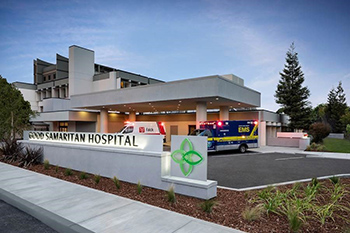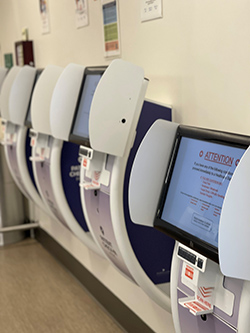
Whether it’s a “weekend warrior” walking in with a broken arm, or an ambulance bringing in someone experiencing a life-threatening stroke, the “front door” of Good Samaritan Hospital is the emergency department (ED). The reimagined facility, which underwent a multi-million dollar modernization less than two years ago, offers patients who need emergency services cutting edge care, innovative technology, and a very different patient experience than they might expect.
“It’s essentially a brand-new emergency department, brought up to the latest and greatest standards,” said Dr. David Feldman, Medical Director of Emergency Services. “It lets us provide a lot of services to patients so they can not only get great care but feel like they got great care, too.”
The ED at Good Samaritan now is three times the size of the one it replaced. That makes it possible to handle more patients while also providing more space for each of them, as well as space for monitoring and diagnostic gear that used to be elsewhere in the hospital, including X-ray and CT scanning as well as a dedicated phlebotomist for drawing blood.

“It’s like moving your family from a cluttered 1,000-square-foot apartment to a brand new, 5,000-square-foot home where there’s a bedroom for each kid,” said Orchid Quiton-Chefalo, Director of Emergency Services for the hospital. “I’ve worked in a lot of emergency departments since 1996 and I can say this is so much more beautiful and spacious than any of them.”
Many of the changes in the ED were designed to give patients a much better experience, one that reduces waiting times, offers them more up-to-date information about their treatment, and helps reduce their stress.
When a patient comes through the doors of the unit, they’ll find automated kiosks where they can check in, providing basic information about themselves and their symptoms. That eliminates long waits to register. There’s even a “concierge” technician in the lobby to help with the process.
As soon as the check-in is complete, a triage nurse is able to see the data and then conduct an initial assessment, followed by a medical screening by a triage doctor. The goal is to have a patient wait no more than ten minutes after walking in the door before they have “a meaningful interaction with the care team so we get to know who you are and what you’re here for,” Feldman said. (The ED averages about 5-6 minutes wait time, Quiton-Chefalo said, and patients can even check waiting times before they come in, online or via text message.)
If a patient needs to be put into a treatment room, they’ll find most of the old-school whiteboards have been replaced by large video screens that keep them up to date on their case in real time. The screens display everything from the names of the doctors and nurses assigned to a patient to the tests that have been ordered, lab results and even the patient’s current reading on the “pain scale.”

“It shows everything, what’s been done, what’s pending, the medications ordered,” said Quiton-Chefalo, who notes that an upgrade to larger screens that’s in progress will even allow patients to see the images from X-rays and other visual diagnostics. “The feedback I get from patients when they see it is ‘wow!’.”
It’s not just in the patient experience that’s changed in the emergency department: So has the way the staff can deliver care.
Telemedicine at bedside can connect stroke patients and ED care teams with on-call neurologists, who can help direct diagnosis and care. In fact, if a patient arrives by ambulance on a “Brain Attack” alert, the “tele-neurologist” will already be at the bedside virtually when the patient arrives. Similar telemedicine technology is available for psychiatric care.
Technology allows a lot of the work to be “done in the background” where patients don’t see it, but it makes a huge difference in their care.
“The data from the check-in kiosk feeds right into the patient’s electronic health record and into our registration systems, so the moment they walk in, our team knows the patient is there and starts developing their care plan,” Dr. Feldman said. “We have a lot of data and electronic tools that let us be efficient, from the time you walk in the door or arrive by ambulance.”
Those efficiencies can translate into better patient outcomes, especially for serious cases like stroke, heart attack or serious infections (sepsis). That’s because reducing the time between patients arriving and getting vital treatment, even by a few minutes, can save lives.
“For a stroke patient, we talk about ‘door to TPA,’ the time it takes before the patient gets a clot-dissolving drug,” Quiton-Chefalo said. “The goal across HCA Healthcare hospitals is less than 40 minutes. Best practice is less than 30 minutes. Our average is 27 minutes, and our best time is 15 minutes. We’re very proud of that we were able to treat our patient quickly.”